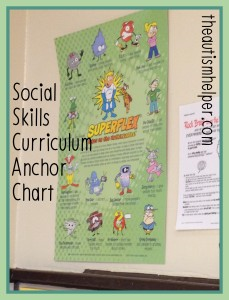By: Margo Ensz on May 27th, 2014
Using Anchor Charts in an Autism Classroom via The Autism Helper
Featured Topics: Differentiated Instruction | Featured Topics: Student Engagement | Academic Subject: Special Education
Visuals are a great way to differentiate instruction for students of all learning abilities, especially students with disabilities. We recently came across a super useful and creative website, The Autism Helper, which offers a blog with plenty of classroom tips, personal testimonials, printables, and lesson ideas from Sasha Long. The article below (all text and images) is a March 18th blog post titled "Using Anchor Charts in an Autism Classroom." There are plenty of other great posts like this one on the website, as well as posted on The Autism Helper's Pinterest account! The anchor charts shown and suggested could easily be made and customized using our Poster Maker or Perfecta.
"Using Anchor Charts in an Autism Classroom"
Sasha LongThe Autism Helper
March 18, 2014
I was maybe a little late the anchor chart band wagon. I get the importance of a method to remind (or anchor) important information into our kiddies’ heads but I was worried having too much on the walls could be overstimulating for my guys. But I think there is way to utilize anchor charts in a way that is majorly beneficial and maintains a visually clear environment. Anchor Charts are basically large visuals, right? How have I not been using these longer?
Keys to Utilizing Anchor Charts in an Autism Classroom:
 Keep the Language Simple: Don’t get fancy. Keep the wording direct and to the point so it will be helpful. Keep in mind the language processing that many of our students have.
Keep the Language Simple: Don’t get fancy. Keep the wording direct and to the point so it will be helpful. Keep in mind the language processing that many of our students have.- Use Color Coding: Color coding helps when you are trying to refer to something that is on the wall way up high and you can’t physically point to. You can then say, “Read the blue one.” Simple genius right there.
- Make It Physically Defined: And a little structure to your anchor chart. In the same way that helps our kiddos understand their environment – it will also help them understand a mess full of words.
- Embed Examples: Many of students don’t truly understand something until they hear some examples. Simply reading a definition can be too much language. Our students are constantly categorizing and discriminating in their mind “If this is like this, than this is a this…” Give them examples with the chart.
 Use Visuals: Duh! Our kids are visual. Make sure the anchor charts utilize visuals when needed. More language is not always better!
Use Visuals: Duh! Our kids are visual. Make sure the anchor charts utilize visuals when needed. More language is not always better!- Provide Anchor Charts for Curriculum Specific Needs: Only put up anchor charts that you will be using on a regular basis. Keep the fresh with what curriculum and activities you are doing. My class is doing a social skills thinking unit called Superflex and we talk about it constantly. This anchor chart is a must have.
- Functional Anchor Charts: Think about what annoying questions you get asked constantly throughout the day that can be easily answered? How about an anchor chart for that? We have a whole anchor chart for commonly used website and passwords and it is a LIFESAVER.

